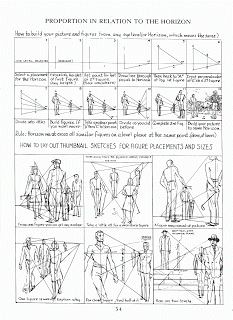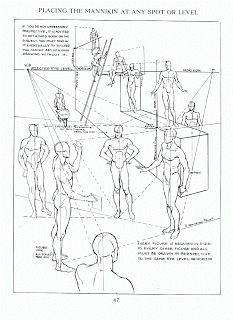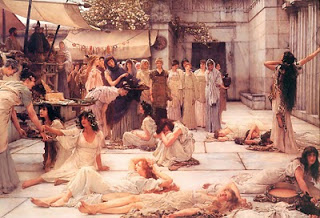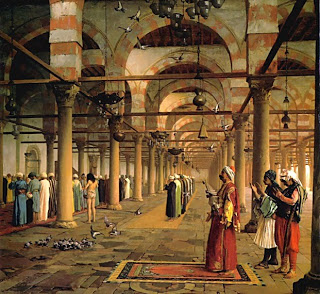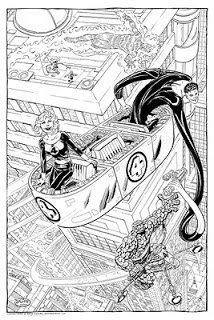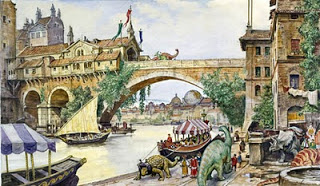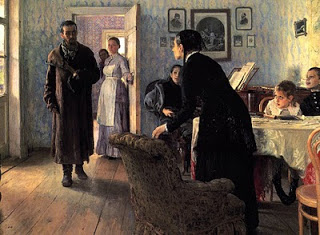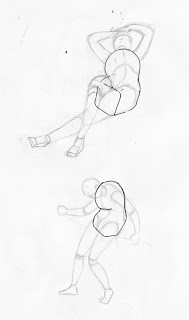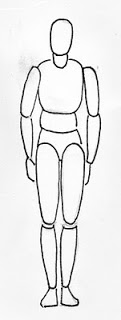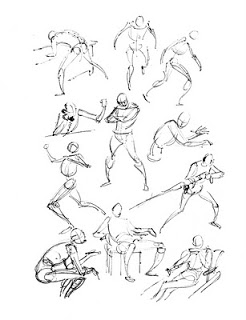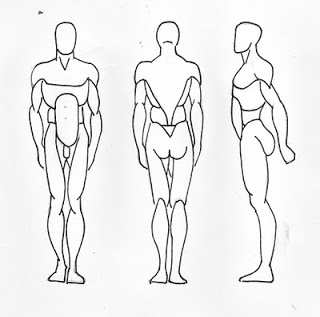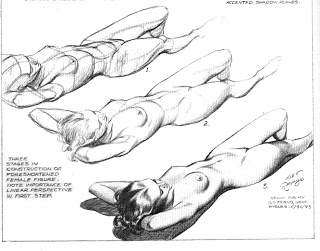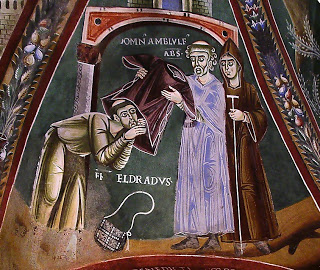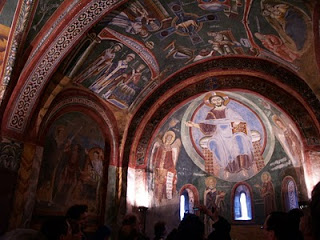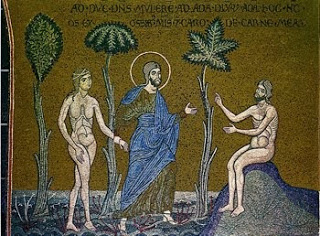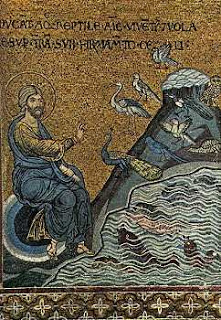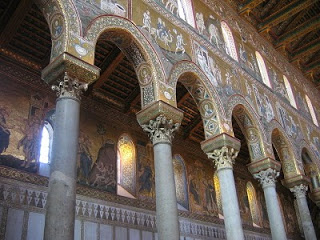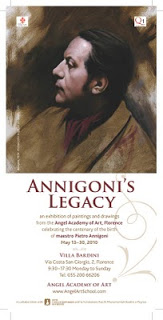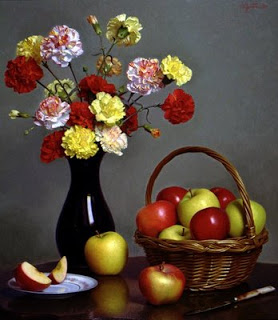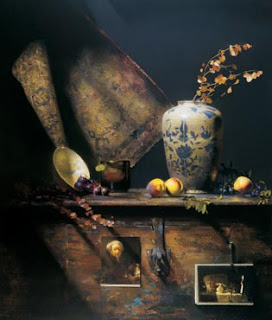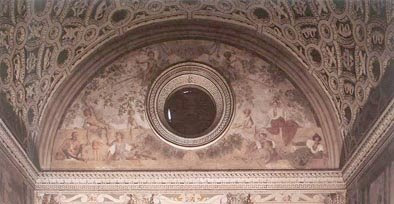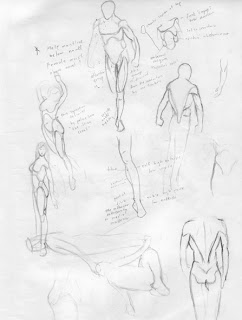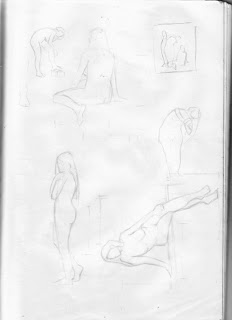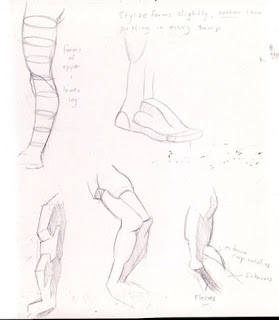Figures in Space 2
After one has spent a considerable amount of time practicing drawing the figure without a model (the old saying goes we all have 10 000 bad drawings in us which we have to get out), the next step is to place those figures in a convincing space.
The following images are taken from Andrew Loomis’ book “Figure Drawing For All It’s Worth” (http://fineart.sk/index.php?cat=1or www.alexhays.com/loomis/). They are an excellent demonstration on how to put the figure into a drawn perspective space.
Leonardo da Vinci using one point perspective:
Examples of other artists placing figures in perspective:
Figures in Space (Drawing from Me Head part 2)
Figurative artists, in order to be successful, must learn two basic skills. The first, taught by a number of academies all over the world, is visual training. Learning to draw is first and foremost learning how to see. In order to master this skill one must spend countless hours copying drawings by old masters and drawing the figure from life all under the critical eye of a qualified instructor. The second skill is the constructive approach to drawing. Here the student learns the basic forms and anatomy of the human figure with the aim to draw the figure from imagination. Below are some hints, leads and images to get you started mastering this skill.
Instructors
Far and away the best instructor in the field of constructive figure drawing is Glenn Vilppu. Check out his website for copies of his wonderful videos: www.vilppustore.com. If you can, buy them all.
This web address contains a number of online articles by him: www.awn.com/category/columns/vilppu
Comic book artist David Finch recently released an excellent drawing dvd:
www.thegnomonworkshop.com/news/2010/02/new-dynamic-figure-drawing-series-with-david-finch
Websites
www.posemaniacs.com/blog/pose
http://figure-drawings.blogspot.com
www.alienthink.com
Books available on the web:
Andrew Loomis was an illustrator and suberb draughtsman in the golden age of illustration. He wrote several books on drawing which are very helpful, particularly “Figure Drawing for All it’s Worth” and “Drawing the Head and Hands”.
They are available online here:
http://fineart.sk/index.php?cat=1
or here:
www.alexhays.com/loomis/
Other Books:
“How to Draw Comics the Marvel Way” by Stan Lee
“Drawing The Head And Figure” by Jack Hamm
The Process:
1. Beginning Form: Start by drawing this simple form of a sphere and cube covered by some material. Do not move forward until you become very good at drawing these.
2. Transitional Form and the Simple Mannequin: The beginning form acts as the rib cage and pelvis. Now add the columns of the legs and arms to make a simple mannequin.
One can also use a mannequin based upon the cube form:
3. Complex Mannequin: Now add simple anatomy. The shoulders and pectorals are grouped together. The external obliques, abs and underwear shape of the pelvis are the other forms.
In the image below notice simple proportions to help you with your mannequin:
Pit of neck to bottom of sternum equals sternum to tenth rib equals rib to pelvic points.
These are the basics, now you only need to draw, draw, draw.
UPDATE: The following images show how to combine superior knowledge of anatomy and the constructive method of drawing:
A Tale of Two Churches
The Cathedral of Monreal and Saint Eldrado are two churches from the same era, on opposite ends of the Italian peninsula, that share much in common and have some important differences.
Monreal, Sicily is located 15 km outside of Palermo and it’s cathedral is one of the most beautiful Christian churches in existence. Commissioned by William II (1154-89), the Norman ruler of Sicily, in 1174 the church is 102m long, 40m wide, 35m high. Its simple exterior hides the rich interior, covered with golden Byzantine mosaics illustrating bible stories. Over 2000 kilos of pure gold were used as the ground for these mosaics. Over looking the entire interior is the beautiful image of Christ Pantocrator (above).
Saint Eldrado is located in the Susa valley, one hour outside of Torino, a part of the Novalesa Abbey. Built on the ruins of an older church, Saint Eldrado was begun in the early 11th century and frescoed at the end of the century. As such, it’s frescoes bear a resemblance to the images in Monreale, most notable the image of Christ Pantocrator(above). The fresco cycles themselves, which illustrate scenes from the lives of Saint Eldrado and Saint Nicola, are in beautiful condition. The Normans too, used this church, most likely before they sent out to cross the Appenines, as the abbey lies at the mouth of the passage. It is a tiny church no more than 4 meters wide by 20 long and continues to be used by the monks to this day.
The Ecstasy of Truth

The German filmmaker Werner Herzog, in recent interview, talked about the role of factual reality in filmmaking. He had this to say about the liberties he takes with facts in some of his documentaries:
“If we are paying attention about facts, we end up as accountants. If you find out that yes, here or there, a fact has been modified or been imagined, it will be a triumph of accountants to tell me so. But we are into illumination for the sake of a deeper truth, for an ecstasy of truth, for something we can experience once in a while in great literature and great cinema.”
This statement applies equally to art. A still life is not simply an even rendering of a group of objects any more than a shopping list is a piece of literature. Take for example the difference between these two “realist” paintings:
The top still life by Stephen Gjertson is an impressive piece, definitely what we would call realist art. There is no denying the artist’s ability to reproduce what he sees onto a flat surface. Everything is clearly represented and experienced to the same degree, which, quite frankly, is a little boring and not representative of we we experience the world around us. In the long run this painting leaves me a little cold.
The second painting by David Leffel is a much more powerful work. It is accurate and abstract at the same time. There are artistic decisions which have been made. He has modified and interpreted reality into a work of art that speaks about how we see and experience reality. This is a painting to be dreamed into and lived with.
We painters need to find our special way to an ecstasy of truth.
Cool Landscapes
Fellow artist and illustrator Mike Sass and I decided to spend the weekend in the Canadian Rockies painting. Saturday was beautiful, warm and sunny.
We were both looking forward to continuing Sunday. Unfortunately the gods had other plans. We woke up to 0 degrees and 10 cm of snow.
Workshops Part Two


I spent a good part of my summer giving workshops in Florence and my hometown, Calgary. The range of student personalities makes these workshops great fun. Students such as: Hank, a retired Pan Am pilot, Kesnia, the Russian animation student, an Italian brain surgeon named Palma, Marvel Comics artist Cary and Aaron, a high school student who is already saving to study with us in Florence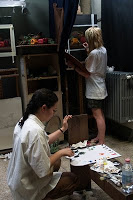
I design the workshops to be fun and informative. That said, they are not easy. As one student said, “I can’t wait to get back to work so I can relax.” 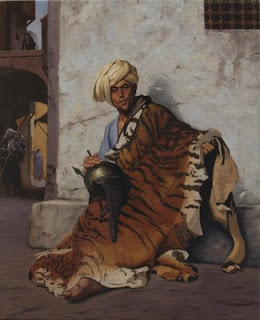
The paintings you see here are student works completed in a two week course.
Villa People

Surrounding Florence are scores of masterpieces tucked away in country churches and small public museums. Some of the most interesting are to found in the Medici Villas which dot the Tuscan landscape. These include: Villa “La Petraia”, Villa of Castello, Villa of Careggi and Villa of Cerrrto, Certainly all of these are worth a visit, but perhaps the most interesting is the Villa of Poggio a Caiano. Designed by Giuliana da Sangallo for Lorenzo the Magnificent in 1480, this villa contains a beautiful garden and the Museum of Still Lives. This museum boasts rooms of paintings from the Medici collections, well presented and rarely visited. The villa itself is a slice of Medici life, including games room, theater, dining rooms and bedrooms. Of particular note is the Salone di Leone X (which takes its name from the famous pope, son of Lorenzo). This room is a showcase of important 16th Cetury frescoes illustrating episodes from Roman history by Andrea del Sarto, Allesandro Allori and Francabigio. The finest work, however, is the lunette by Pontomoro. A mannerist masterpiece, it depicts the divinities Vertumnus, god of harvests and Pomona, goddess of fruit tress.
The villa is a 50 minute trip from Florence. For 2 euros one catches the COPIT bus next to the MacDonald’s on via Nazionale. Phone the museum ahead for a reservation (see number below), pack a lunch to eat in the garden and enjoy a day out of the city.
After the villa, and seeing as how you are in the neighborhood, it is a short bus ride to Carminiagno, where a second Pontoromo masterpiece, “The Visitation”, resides in the church. You can buy a bus ticket (95cents one way) at the bar across the street from the villa and catch the bus directly in front of the villa. Ask for directions to the church when you arrive. Not much else to see there, but be sure to try some of the local sweets and indulge in a bottle of wine from one Italy’s finest regions.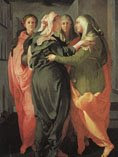
Villa Poggio a Caiano 8:15 – 12:30 2:00 -18:30.. Closed the 2nd and 3rd Monday of the month.
Still Life Museum 055 877012
Both are free to visit.
Trying to be a Florentine

It is sometimes a strange thing living in Florence. In fact the word for foreigner in Italian is straniero, which literally means stranger. And a stranger is exactly how foreigners are treated here. Florentines have a reputation for staying distinctly separate from the 7 million strangers who come to their beautiful city every year. Sometimes though, we foreigners do not make enough of an effort to break through that wall. I joke that not much has changed here in 500 years, yet I often choose to watch the news in English on the internet instead of the local Italian version. I still struggle to express myself in the Italian language. I teach in English, there is a large number of English speaking expat artists here and even the Italians want to speak English with you. It makes it very easy to be comfortable not speaking Italian. I was on my way to becoming like my Italian grandmother who lived in Canada for 50 years and never learned more than a few words of English.
But I had an excuse. Really. I had been preparing to leave Florence for South America and so I felt no need to study Italian. Instead I was focusing my attention on Spanish. When that move fell through I decided I to get the most out of my life in Florence.
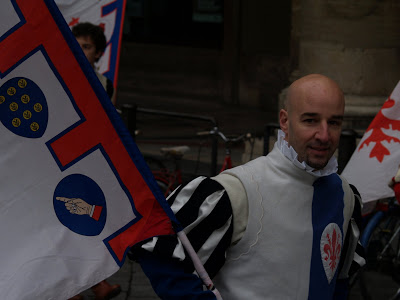
What I did was join the “Bandierai degli Uffizi”. These are “The Flagwavers of the Uffizi”. This is the official flagwaving group of the city of Florence. The “Bandierai degli Uffizi” are integrally connected to the history of Florence. The group carries the flags which represented the pricipal Magistracies and legal offices of the powerful 16th century Florentine Republic. We perform at major events in Florence and throughout Italy, the E.U.and the world.(Check out the website:http://www.bandieraidegliuffizi.it)
I have been practicing for almost a year and am finally good enough to perform in the events. One of the most important is the Easter celebration and that was where I made my debut a couple of weeks ago (That’s me in the photo above). You can watch it on You Tube.
http://it.youtube.com/watch?v=_jJ_HDgiTIU
Kudos if you can see me.
I feel quite proud to be able to represent Florence in an official way. These flagwavers are a really great group of guys among which I have made some genuine friends. Although my accent is constantly made fun of I have managed to immerse myself in Italian. Not really though because these fellas speak the Florentine dialect, and with their soft ‘c’ and slang even my dictionary is of no help. None-the-less after 7 years I am starting to know a new part of this city. And it just makes it more beautiful.
Drawing from me head!
I have been working on a a program that would develop in students the ability to create and draw the figure from imagination. This an area that is overlooked in the drawing programs of many currents art schools where students are taught to copy and render the model without analyzing it in a way which allows them to create figures without a model. The ability to compose wothout a model is a necessary skill not only for fine artists but more so for students wishing to work as illustrators and concept artists with the film and gaming industries. ( Both of which offer many opportunities). I am consolidating ideas from a number of sources including: The Angel figure drawing program, Andrew Loomis’ books, Glen Vilppu’s drawing manual, Leonardo’s notebooks, the sketchbooks of Adam Hughes, Bridgman’s Drawing manuals and Strength Training Anatomy by F. Delavier. The first student of this program is me. Below are some of my sketchbook pages:

